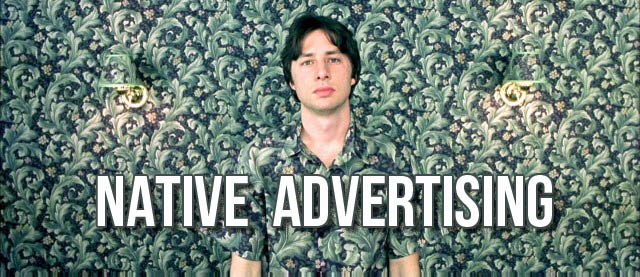 Unlike interrupt advertising where ad matter is interjected into the TV program or any other media, native advertising integrates marketing content with a site/service in such a smooth way that it cannot be distinguished from other material there either in terms of style, format, content or placing. Native advertising is becoming a useful tool for branding. Because it is shown like any other content on a website, users don't have to see or read it; only if it interests them they can read it. However, under federal laws, native advertising that does not look like advertising must divulge its source.
Unlike interrupt advertising where ad matter is interjected into the TV program or any other media, native advertising integrates marketing content with a site/service in such a smooth way that it cannot be distinguished from other material there either in terms of style, format, content or placing. Native advertising is becoming a useful tool for branding. Because it is shown like any other content on a website, users don't have to see or read it; only if it interests them they can read it. However, under federal laws, native advertising that does not look like advertising must divulge its source.
As you would expect, many people are asking the question: Is this kind of advertising truly new or simply repackaged advertorials for our digital age? Some authorities in the field prefer not to mince their words. "It's purely advertorial," one says bluntly. He adds that it's appears to be a sexier, digital repackaging of an old idea - and when paid ads become part of editorial matter, they are advertorials, plain and simple. Since ‘native advertising' sounds new marketers love it. Native advertising aims to elevate an ad message by making it look like the real, impartial content users seek. However, when it is disclosed that the specific content is sponsored or paid for, it's fine. But if marketers don't divulge this, then users will get confused and the value of the whole media world will get disturbed, one expert opines.
Some feel that native advertising is akin to ‘old' advertising tools like infomercials, soap operas and ‘special sections' in newspapers and magazines. It's something old that has become new again. It's useful when used in the right place, but maybe it won't replace the banner ads. Besides, users are smart enough to differentiate between content meant for general consumption and content aimed at selling a service or product. The Economist has the last word on native advertising: "….one method for marketers to use content to engage with readers in a way that is more effective than standard advertising," says its managing director.
Here are some statistics that tell how native advertising is currently being used:
- Facebook is the favorite place for brands to use native advertising.
- 62 percent of publishers are now offering native advertising. This is followed by 41 per cent of brands and 34 percent agencies.
- Blog posts, which account for 65%, are the most popular types of native advertising. For articles the figure is 63%, for Facebook 56%.
- 66 percent of brands claim that they write their native advertising content themselves.
Guide to Native Advertising Methods
Here's a guide to the various kinds of native advertising and advertising that comes close to being native.
True native advertising comprises a group of advertising strategies that aims to incorporate advertising totally into the digital content. Online sponsored content, Facebook brand stories and Twitter's promoted trends are popular ways of native advertising.
But the ‘tourist ad' is not really native. This type of ad is not unlike regular banner ads. It's a kind of digital version of the huge foldout sections of newspapers that governments buy sometimes to promote foreign investment. Tour ads usually have these features:
- They are ‘super banners' - They are basically bloated banner ads with well-designed layout and oversized.
- They have useful content — These ads provide useful value to users. Their content is more than the ‘check this out' variety.
- They have many features - At one go they use text, video and imagery, which is a common trait of ‘tourist' ads.
- They provide social functionality - Sometimes these ads incorporate voting and commenting functions which encourage more user engagement.
Resident Advertisements
Resident ads move beyond tourist ads by integrating themselves more fully into a website, intimating that the unit is part of the site's content. Resident ads normally have these features.
- All Dressed Up - Publishing partners of resident advertising networks modify units so that they resemble the basic content layout of the site. When this is done, users may not be conscious of the fact that they are being served by a third party.
- Use New Spaces - Instead of fitting into the content model of a site, resident units sometimes are represented as new kinds of ad units, using space the bottom of the articles or between paragraphs to display their content.
- Third Party and Local Content — Resident advertisements sometimes simultaneously display appropriate content from the publisher site and from a larger network too.
Citizen Advertisements
Citizen ads embed themselves further in the content flow. Here are some of their characteristics.
- Complement the style of the site — Citizen Ads, like resident ads, fit into the style of the content and layout around them flawlessly.
- Part of consumption experience –These Ads become part of the users' experience and not as distinct content.
- Aspects of core content — Citizen Ads are really presented as a basic part of the content experience.
Truly Native Advertisements
Advertisements that are fully native provide the best of both traditional and paid advertising. They comprise content which users can quickly recognize as sponsored, but are still easy to engage with, like the ‘sponsored stories' of Facebook, for example. Let's take a look at some of the features of these ads.
- They can be shared with other content-Facebook's sponsored stories can be liked, shared, commented upon, etc. This is a crucial aspect of native ads.
- They look same as the site's other content — Facebook's sponsored stories look the same as other posts in your feed - except for the highlighted matter.
- Part of the consumption experience - The sponsored stories appear in your feed, alongside your usual updates.
One thing stays consistent on all native frameworks — native ads often do better than banners on key parameters like Click through Rate (CTR). Even then native CPMs (Cost Per Mille) are currently not that much higher than the CPMs on banner advertisements, at least for now. Since native ads are a new concept, this is not surprising. Advertisers must thus take advantage of this variance between effect and cost. They should exploit it while they can.
Future of Native Advertising
Experts across the field of social media feel that native advertising is not just here to stay but it will grow exponentially. One analyst goes so far as to say that all advertising on the social media networks in the future will be native and that banners and right rail will disappear from the scene.
There are several reasons for this optimism.
Native in-stream advertising is exactly what brands want. As they aim to develop campaigns across all PC and mobile devices, the seamless functioning as well as the looks of native advertising appeals to them.
- Advertising spent on mobiles last year was higher by 83% over the previous year at $8.9 billion, due to the great experience on the small screens of mobiles.
- Twitter began the trend with its Promoted Tweets in 2010. Twitter now is a big influencer of the development of TV ads and digital ads working together. This social media network now offers a set of 3 varied in-stream native advertising creations.
- Networks which promote a video and image sharing like Vine, Snapchat and Pinterest will soon offer picture-centric ads which will be very effective for native advertising. It's a well-known fact that pictures constitute the most shared kind of content on the Web with 43% of users around the world having shared a picture in the last month.
- An analyst predicts that as much as $11 billion will be spent on ads on the social media in 2017 of which 40% will be native ads and the growth rate will become faster as time goes by.
Summing Up
Thus, while traditionalists may call them ‘advertorials' that can hurt the media itself, there's no denying the convenience and effectiveness of native advertising. As more social media networks dream up ways to promote this kind of advertising, it's more than likely that it will keep on growing.
Stephen Moyers is an active tech-savvy blogger who loves to write about online marketing, Social media marketing and various technology topics. He is currently associated with Spinx Digital, a Los Angeles based Digital Marketing Agency which provides a range of services like Social Media Marketing, Website Design & Development, Search Engine Optimization and many more. You can follow Stephen on Twitter.







